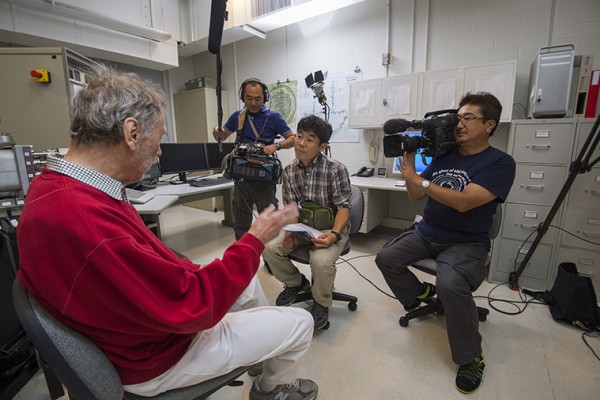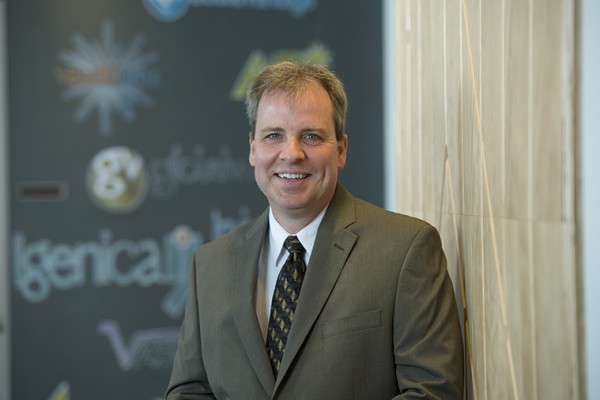Arts & Sciences faculty honored
Arts & Sciences faculty (from left) Jami L. Ake, PhD, John M. Doris, PhD, Mark Rollins, PhD, and Douglas L. Chalker, PhD, were recognized for their teaching and leadership during Arts & Sciences’ annual faculty reception this month. Ake and Chalker both received the Distinguished Teaching Award; Doris received the David Hadas Teaching Award; and Rollins received the Distinguished Leadership Award.
Politicians have power to change voters’ minds, study shows
Politicians who take a stance on tax increases, immigration reform, marijuana legalization and other controversial issues have the power to sway voter opinions in their favor and they can do so without fear of backlash, according to new research from Washington University in St. Louis and the University of California-Berkeley.
Japanese film crew talks stardust with physicists
A film crew from NHK, the Japan Broadcasting Corp., visited the Danforth Campus of Washington University in St. Louis last week to film for a series called “Cosmic Front HOTLINK” about the wonders of the universe. Here, they interview Ernst Zinner, PhD, research professor of physics in Arts & Sciences. He pioneered techniques to study tiny bits of matter from stars that died before the solar system was born.
Fazzari to chair new sociology department in Arts & Sciences
Steven Fazzari, PhD, a leading scholar on the relationship between rising income inequality and macroeconomic trends in the United States, will be chair of the recently re-established Department of Sociology at Washington University in St. Louis, Barbara A. Schaal, PhD, dean of the Faculty of Arts & Sciences, has announced.
‘The process by which drugs are discovered and developed will be fundamentally different in the future’
Over the past several decades, Michael Kinch of Washington University in St. Louis says, the pharmaceutical industry has managed to dismantle itself. In a provocative series of articles and interviews, Kinch, the director of the Center for Research Innovation in Businessat the university, has been describing the history of this dismantling and its implications for the future of medicine.
‘Divided City’ project to examine segregation from variety of perspectives
Legal segregation may be over, but segregation is hardly a thing of the past. This fall, the Center for the Humanities in Arts & Sciences and the Sam Fox School of Design & Visual Arts will launch “The Divided City: An Urban Humanities Initiative.” The $1.6 million project — funded in part by a four-year, $650,000 grant from the Mellon Foundation — will examine segregation from a variety of perspectives.
Forgotten history: Gloria Rolando screens film Oct. 13
In “Reembarque/Reshipment,” Cuban filmmaker Gloria Rolando examines the lasting influence — on Cuban language, music and culture — of Haitian laborers, brough to work the sugarcane fields and coffee plantations. At 6 p.m. Monday, Oct. 13, Rolando will host a free screening in the Danforth University Center.
Jazz at Homes celebrates Gaslight Square Sept. 25
In the 1950s and ’60s, Gaslight Square hosted a who’s who of American entertainers — everyone from Lenny Bruce to Miles Davis to Barbra Streisand. On Thursday, Sept. 25, Washington University will pay homage to Gaslight Square with a special Jazz at Holmes concert.
Braxs receives Hispanic heritage award from NFL
The St. Louis Rams have selected Virginia Braxs, senior lecturer in Romance languages and literatures in Arts & Sciences, as a recipient of the NFL Hispanic Heritage Leadership Award.
Next up in Assembly Series: Focus on race, culture and identity
The Assembly Series will feature next week speakers who explore issues of race, culture and identity — in two distinct ways. At 5 p.m. Monday, Sept. 29, race and gender scholar Roderick Ferguson, PhD, will deliver the annual James E. McLeod Lecture on Higher Education. At noon Tuesday, Sept. 30, legal and literary scholar Patricia J. Williams, JD, will speak for the Interdisciplinary Project in the Humanities’ annual lecture series. Both are free and open to the public.
View More Stories


